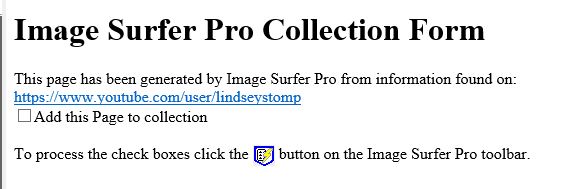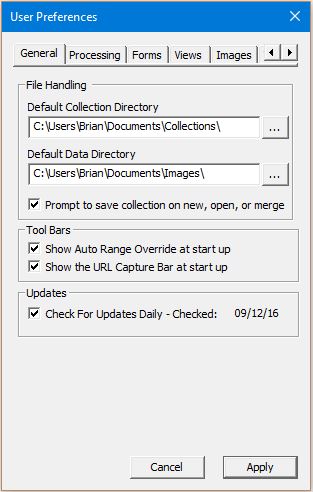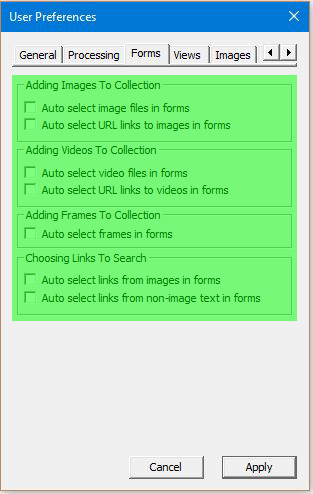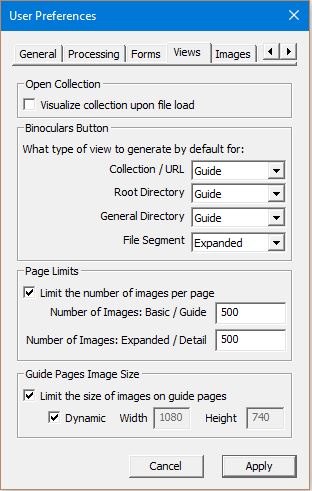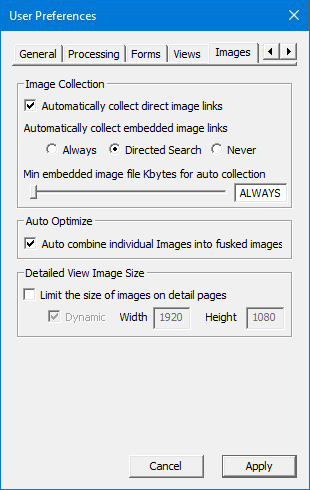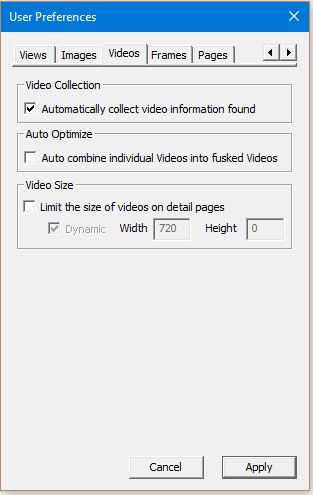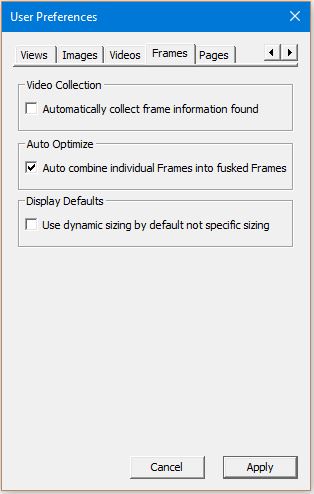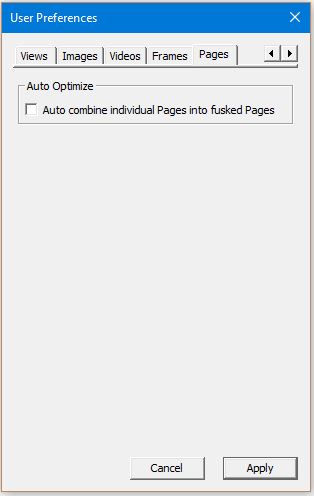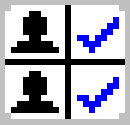 Image Surfer Pro Forms
Image Surfer Pro Forms
The ISP Forms Button
This button can be used in several ways and is integral to getting accurate and safe links to the media files you want to collect. The central functionality of this button is to pull out media file information and hypertext links from the current webpage and display the information in a set of tables which allow you to choose which information to add to your fusker collection.
For a better understanding of how an ISP Forms can be utilized chose one of the following topics:
- Provide safer and more private browsing
- Select specific media files from the current webpage for addition to your fusker collection
- Initiate a Directed Search for more media file information
The following sections discusses how the ISP Form is created and presented.
Image Surfer Pro Forms
The ISP Form button extracts the information from the webpage in the current IE browser window and generates a custom webpage based on that information. The current browser window is then re-directed to this custom webpage.
The custom webpage generated consists of a header and four tables. Each table is dedicated to a particular type of information found on the original page and has a different border color to help distinguish the type of data presented in the table. The tables are always presented in the following order:
- The Video Table contains videos (MP4 Files) found on or embedded in the webpage.
- The Frame Table contains frame information found in either <IFrame> of <Embed> constructs within the webpage.
- The Image Table contains images found embedded within the original webpage along with any hyper link associated with the image.
- The Other Content Table or sometimes called the Text Table contains bits of text or HTML code found which was associated with a hyper link on the original webpage.
- Add Boxes: these boxes allow you to select specific URLs for inclusion in your fusker collection
- Search Boxes: these boxes allow you to specify which additional page links you wish to have searched for additional media content.
Just above each table are a set of page hyper links which can be used to quickly get to any of the tables or back to the top of the ISP Form. These can be handy when the original page contained a lot of media references.
ISP Form Header
The Video Table

The video table will always be the first table seen in an ISP Form. The table is shown even if no video information was found on the original page. The video table has a GREEN border and has two columns. Because videos are interactive objects on a webpage they are not used to link to other content or pages (clicking the video toggles playback of the video), so no column is needed to display associated hyper links.
The first column (#) is simply a content row number. Row numbers span tables and the first row with actual content is labeled as 1. The row number is then incremented by one for each subsequent row of content displayed. These numbers are simply for reference.
Information Extracted
All videos(MP4 Files) found embedded in OR referenced by the original webpage are displayed in the order the file information was found on the original webpage.
How Videos Are PresentedThe second column (Video Content) displays any video information extracted from the original webpage. Each video is presented on an individually numbered content row and shown only once. If the same video seems to appear more than once in the table, the URL of the MP4 file must be different between the two videos.
Each video is shown at a maximum width of 640 pixels regardless of the actual size of the video to assure page formatting does not require a horizontal scroll bar.
Video files are fully interactive and you may play each video presented in the table or even have several playing at the same time.
In some cases a video from the original webpage may not be presented in the video table of the ISP Form created from the original webpage or the presented video may not work. This can happen for several reasons. What appeared to be a video was actually a frame or other object (Know your media types) check to make sure the video is not visible in the Frame Table.
Display of the video file may be protected and not accessible from outside the hosting domain or in other ways such that the video simply will not display. In these case the poster image for the video may still be visible but with an indication of Invalid Source.
The Frame Table

The frame table has a RED border and has two columns. Because frames are interactive objects on a webpage they are not used to link to other content or pages, so no column is needed to display associated hyper links.
Row numbers in the first column continue to increment from the video table with each frame presented.
Information ExtractedThe source data for <IFrame> and <Embed> constructs on the original webpage which are not MP4 files will be extracted and displayed in the frame table. If the source data for one of these constructs was in fact and MP4 file reference the video will be displayed in the video table.
In some cases these constructs are used to display content which the current version of Image Surfer Pro is not capable of working with and the data will be ignored.
How Frames Are PresentedThe second column (Video Content) displays any frame information extracted from the original webpage. Each frame is presented on an individually numbered content row and shown only once. If the same frame seems to appear more than once in the table, the URL of frame source must be different between the two frames.
Each frame is shown at a maximum width of 640 pixels regardless of the actual size of the video to assure page formatting does not require a horizontal scroll bar.
Frames are fully interactive and you may interact with multiple frames and have several streaming content at the same time. A warning about frame content being active is displayed above each of the frames - make sure you understand the security risks of interacting with active content prior to interacting with any frame presented on an ISP Form.
In some cases a frame from the original webpage may not "work" or "display" any content. This is actually relatively common because of the way frames are embedded on webpages. The same encoding on a webpage not hosted by the same domain may not be able to resolve the connection to the intended content. In some cases (such as YouTube) display of the URL used on the hosting page will be blocked from being displayed by frames on other pages.
A Frame that can not be displayed in an ISP Form will typically appear as black boxes. Frames are often used to display active advertisement content. Sadly, while many video frames will not display in an ISP Form these advertisements usually will.
If the frame you wanted to collect does not work in the ISP Form, try going back to the original webpage and look for a link to the Embed Code for the frame. This can often be found by right clicking on the frame video. This is the case on most top tier Tube Sites (such as YouTube). Paste the Embed Code into the URL Capture Bar to add the frame to your fusker collection.
The Image Table

The image table has a BLUE border and has three columns. Images are often used as hyper links on webpages, sometimes to other images as in a Free Hosted Gallery page or to other pages as on a Thumbnail Post. If a link is associated with the image it will be shown in the right most third column.
Row numbers in the first column continue to increment from the frame table with each image presented.
Information ExtractedThere are many ways an image may be made visible on a webpage. In most cases Image Surfer Pro will find the URL of the image file easily enough. This includes graphics used as buttons and other form inputs. In a few cases (such as background images) the image file URL is in the CSS file and not available in the HTML code provided to Image Surfer Pro by IE.
When an image is used as a hyper link, the destination URL of the hyper link will also be extracted and associated with the image. Several different versions of the link will be displayed in the third column of the table on the same row the associated image is shown in the second column. The separation of the link and the image allows you to be certain of what clicking on the link will do.
How Images Are PresentedThe second column (Image Content) displays any image as an image. The width of each image is constrained to one half the width of the IE Display Window at the time the form is created - this assures the table fits cleanly within the display window with no horizontal scroll bar.
Each image is presented on an individually numbered content row but may appear several times within the table. Each image will be present each time the image is visible on the original webpage. The images are presented in the order they were found in the HTML code of the original page - which may or may not be the order they appear in the display of the original page.
Each image in the table is also a direct link to the image file. Clicking on any image will navigate the IE browser window to the direct display of the image URL.
In some cases an image from the original webpage may not "work" or "display" on the ISP Form. This happens when access to the image is restricted to pages from the same domain or in some other way. If the image can not be directly referenced by pages created by Image Surfer Pro the image will appear as:

The Link Table

The link table has a BLACK border and has three columns. The table contains all remaining hyper links from the original webpage. This table will typically be the largest of the four tables unless the original page had images as it's primary focus.
Row numbers in the first column continue to increment from the image table with each link presented.
Information ExtractedThe destination of any hyper link on the original page which was not associated with an image will be extracted and displayed in this table. Image Surfer Pro does it's best to capture the pure text or other HTML code snippet which was associated with the hyper link.
How Links Are PresentedThe second column (Other Content) attempts to display the webpage content which would have been clickable to access the hyper link to help you recognize what portion of the page the link was found on. If the link surrounded pure text the result is basically self explanatory as the text (such as Next Page) will be visible in the table. This isn't always the case. When the link is not referenced by plain text, Image Surfer Pro attempts to change the HTML code which was the clickable object into plain text. Even this process sometimes results in nothing visible to place in the second column of the link table.
What will always be visible are the various forms of the link's destination URL in the third column. Each link is simply displayed as a pure text reference of the destination URL itself. Each link is presented individually on a separate row in the order in which the links were found in the HTML code of the original page. Some links may be duplicated in the table if they were presented more than once on the original page.
Selection Boxes
ISP Forms are literally covered in selection check boxes! There are two types of check boxes distinguished by the wording of the boxes:
To better understand how to use these selection boxes choose which boxes you wish to read more about.
